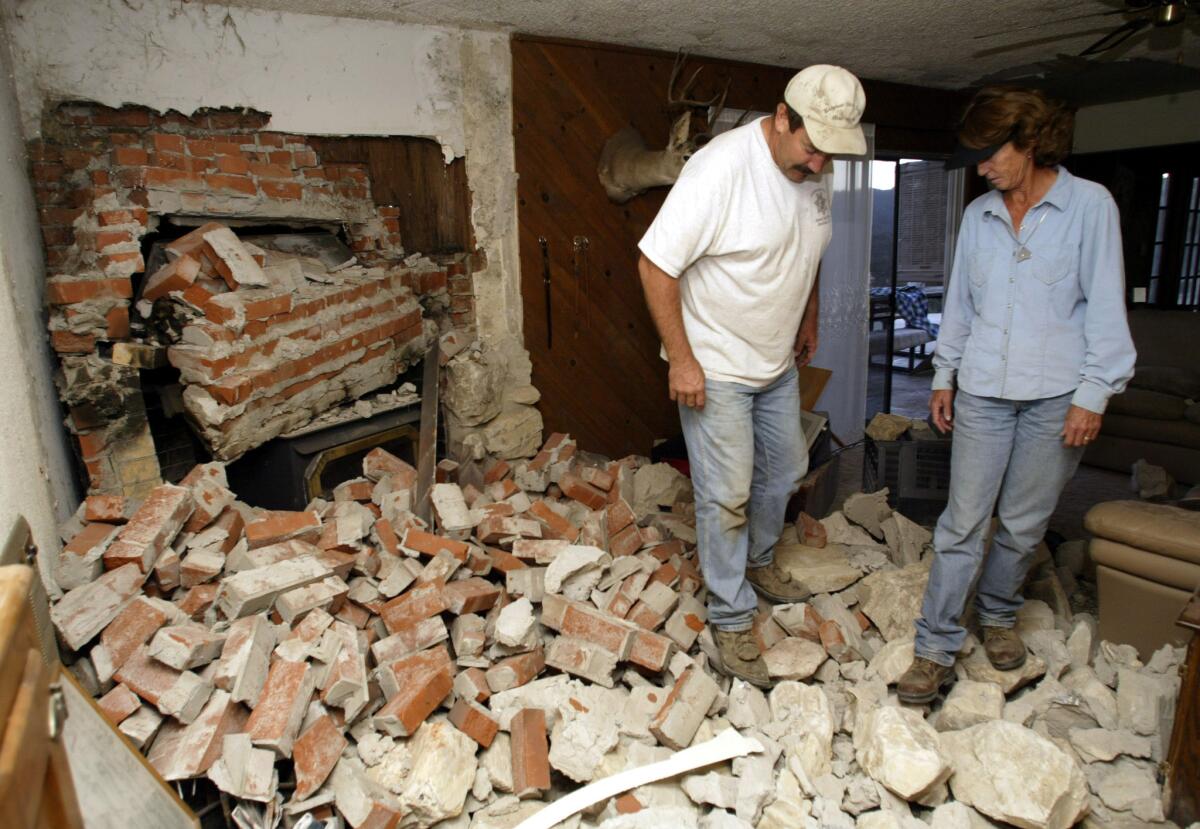USGS slams study’s claim of 99.9% chance of large L.A. earthquake

A couple survey the damage to their Parkfield home after a magnitude 6 earthquake hit southern Monterey County in 2004.
- Share via
The U.S. Geological Survey is raising serious doubts about a recent study that calculates a 99.9% chance of a large earthquake in the Los Angeles area in the next three years.
The USGS took the rare step of issuing a statement raising questions about the study, recently published in the journal Earth and Space Science and coauthored by a research scientist at NASA’s Jet Propulsion Laboratory in La Cañada Flintridge.
“I have serious doubts that the conclusions of the paper are supported by the analysis that’s presented there,” Robert Graves, a USGS seismologist and Southern California coordinator for earthquake hazards, said in an interview Wednesday. The study lists Graves as a consultant who helped with calculations for the study, but Graves says he has deep concerns about the study.
The USGS said in a statement that the study’s forecast “has not yet been examined by the long-established committees that evaluate earthquake forecasts and predictions made by scientists.”
The study calculated a 99.9% probability for a magnitude 5 or larger earthquake to strike the greater Los Angeles area between April 1, 2015, and April 1, 2018. Specifically, the study’s authors were looking at the chance of another significant temblor within a 60-mile radius of the 5.1 magnitude quake centered in La Habra last year.
The La Habra earthquake, which hit on March 28, 2014, was powerful enough to knock people to the floor, crumble brick walls and displace people from homes and apartments too damaged to occupy.
Graves said the 99.9% figure is suspect.
“It does not seem like a reasonable number,” Graves said. “There’s no information from that paper that that number can be substantiated.
“The 99.9% number -- I don’t know the method that was used to derive that. But basically, that’s saying that’s going to happen. And that level of certainty, to my knowledge, is just not attainable. We can never be that certain.”
The probability used by the USGS for such a magnitude 5 or greater earthquake in this area over the next three years is 85%, Graves said.
The study’s lead author, Jet Propulsion Laboratory principal research scientist Andrea Donnellan, said in an interview that the 99.9% figure was not a central conclusion of the paper and should not be viewed as an official forecast.
“As scientists, we were not putting out an official forecast. We were putting out something in a paper to test,” Donnellan said.
Donnellan said she considers the 99.9% number a test of a model, or algorithm, on the probability of future earthquakes.
“We never said in this paper we were predicting an earthquake. And we said that’s the probability of an event,” Donnellan said. “There is still a 0.1% chance it won’t happen. So we need to test it. And that’s what we are doing as scientists.”
She added that the USGS’ 85% probability and her 99.9% chance still favored a big earthquake in the next three years.
“If an earthquake happens in three years, we’re both right,” Donnellan said.
Donnellan said the 99.9% figure was actually a small point in the study. The study’s central conclusion was that the deeper layers of the earth did not move in the La Habra earthquake like the shallower areas did. That suggests that the deeper layers still have seismic strain, and an earthquake will eventually have to come to release that strain.
Graves said how the scientists came to that conclusion, too, is unclear. “The specifics in terms of the modeling, it’s a little difficult to tell the details; it’s not fully described in the paper,” Graves said.
Although Donnellan characterized the 99.9% number as not a central conclusion of the report, that number has dominated public discussion about the study.
And Graves said he finds that unfortunate, because he said he doesn’t think the 99.9% probability of a large quake in three years is supported by the information released in the study. He said the 85% probability is a better number.
“The taxpaying public deserves to get quality, reliable information and that’s what we’re striving to do,” Graves said. The 85% number was forecast as part of a comprehensive update to earthquake forecasts, called the Third Uniform California Earthquake Rupture Forecast, also known as UCERF3, which was developed by a broad array of scientists over several years.
The idea that earthquakes can be predicted at a particular time and location is often tantalizing, but is not rooted in sound science, Graves said. In trying to forecast the next big quake by location and over a certain date, scientists have endured an “evolving process of eating crow and understanding how little we understand.”
One of the most famous times when scientists tried to predict the next earthquake was along the San Andreas fault around the Central California town of Parkfield. A big earthquake had occurred there an average of every 22 years between 1857 and 1966, so scientists forecast a 95% chance that another magnitude 6 or greater earthquake would hit between 1988 and 1993.
They were wrong. The next big earthquake came more than a decade later, in 2004.
Follow me for the latest news in earthquake safety, El Nino and the drought: @ronlin
ALSO
Congressional Republicans demand plan for collecting El Niño water
Cheese really is crack. Study reveals cheese is as addictive as drugs
Fresh & Easy begins closing down stores
More to Read
Sign up for Essential California
The most important California stories and recommendations in your inbox every morning.
You may occasionally receive promotional content from the Los Angeles Times.











